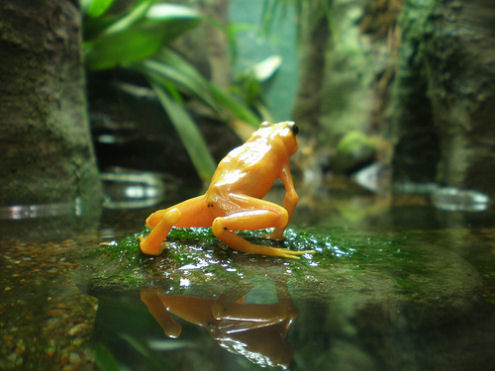Golden Poison Dart Frog (Phyllobates Terribilis), The Most Poisonous Frog In The World
This article is part of our Environment section
See the complete list of all our Articles about Rainforest Animals here.
The golden poison dart frog is probably one of the most exciting frogs to learn about as it is thought to be the most poisonous (toxic) frog in the world. (Ref. 1)
 Golden Poison Dart Frog
Golden Poison Dart Frog © Thomas Joulin
We can only find it in the lowland rainforest of the Pacific coast of Colombia. (Ref. 2)
The golden poison frog measures around 47 mm and is one of the largest frogs of the Dendrobatidae family. (Ref. 3)
The adults of this frog species are uniformly golden or pale metallic green in colour. (Ref. 4)
It is one of the 3 species of poison dart frogs which are definitely known to be used for dart poisoning by the Embera Indians of Colombia. (Ref. 5)
Charles W. Myers and co-authors point out that one frog may contain up to 1900 micrograms (µg) of toxins. (Ref. 6)
They warn that “these frogs should be considered as potentially dangerous [to humans] if improperly handled” (ref. 7) as even “a small fraction of the poison from one of the … frogs would be lethal to man if gotten into the bloodstream through an open wound. The skin secretions are also irritating to porous skin and poisonous if ingested.” (Ref. 8)
Thanks to its bright colours and extreme toxicity, this species of frogs has virtually no predators, apart from man and probably one species of colubrid snakes. (Ref. 9)
In their reproduction behaviour the golden poison dart frogs are similar to other poison dart frogs. The female lays her eggs on the ground. After the eggs get fertilized, the male and the female will both look after them (to keep them moist) until they hatch. (Ref. 10) The males will transport the tadpoles to their permanent pools after hatching. (Ref. 11)
Is the golden poison frog an endangered species?
Just like in case with the blue poison dart frog, the fact that its habitat is restricted to a specific geographical area in Colombia makes the golden poison frog vulnerable to changes.
The IUCN Red List of Threatened Species lists this frog as an Endangered species “because its extent of occurrence is less than 5,000 km², all individuals are in fewer than five locations, and there is continuing decline in the extent and quality of its habitat in Cauca Department, Colombia”. (Ref. 12)
The IUCN reports that deforestation of the frog’s habitat (for different purposes, such as agricultural development, the planting of illegal crops, logging and human settlement) is the biggest threat to its existence. But international trade in this species has also been mentioned as one of the threats. (Ref. 13)
Written by: Irina Bright
Original publication date: 2007
Republication date: 2020
References
1. Golden Poison Frog. (September 21, 2007). In Wikipedia, The Free Encyclopedia. Retrieved September 24, 2007 from http://en.wikipedia.org/w/index.php?title=Golden_Poison_Frog&oldid=159453674
2. Myers, C. W., Daly, J. W., & Malkin, B. (1978). A dangerously toxic new frog (Phyllobates) used by Embera Indians of Western Colombia, with discussion of blowgun fabrication and dart poisoning. Bulletin of the American Museum of Natural History, Vol. 161: Article 2, New York (PDF file retrieved from the Digital Library of the AMNH: http://hdl.handle.net/2246/1286), p. 311
3. Ibid.
4. Ibid.
5. Ibid.
6. Ibid.
7. Ibid, p.312
8. Ibid.
9. Ibid, pp. 326 - 327
10. Golden Poison Frog. (September 21, 2007). In Wikipedia, The Free Encyclopedia. Retrieved September 24, 2007 from http://en.wikipedia.org/w/index.php?title=Golden_Poison_Frog&oldid=159453674
11. Bolívar, W. & Lötters, S. 2004. Phyllobates terribilis. In: IUCN 2007. 2007 IUCN Red List of Threatened Species. Retrieved September 17, 2007 from www.iucnredlist.org
12. Ibid.
13. Ibid.